ADD ANIMATIONS
You can animate the objects on your PowerPoint slides. PowerPoint provides four types of animations: Entrance, Emphasis, Exit, and Motion Paths. An Entrance animation determines the manner in which an object appears on a slide; for example, an object can move onto a slide. An Emphasis animation does something to draw attention to an object; for example, the object can become larger. An Exit animation determines the manner in which an object leaves a slide; for example, an object can move off a slide. A Motion Paths animation determines how an object moves around a slide; for example, an object can move from left to right.
After you add an animation, you can use the Custom Animation pane to modify it by choosing an effect. Choosing an effect enables you to define what starts the animation, its properties (such the direction from which an object moves onto the slide), and control the speed of the animation. In addition, you can have an animation start when you click the mouse, start along with the previous animation, or start at a specified time after the previous animation.
If the Auto Preview box is checked on the Custom Animation pane, PowerPoint provides you with preview of your animation after you create it and each time you modify it. You can also use the Play button on the Custom Animation pane to preview an animation.
To choose an effect:
- Select the object you want to animate.
- Choose the Animations tab.
- Click the Custom Animation button. The Custom Animation pane appears.
- Click the Add Effect button. A menu appears.
- Choose the type of effect you want. A submenu appears.
- Click the effect you want. PowerPoint applies the effect.
To modify an effect:
- Click the down arrow next to the Start field on the Custom Animations pane and then select the start method you want.
- Click the down arrow next to the Property field on the Custom Animations pane and the select the property you want. The Property field might be labeled Direction, Size, or some other property.
- Click the down arrow next to the Speed field on the Custom Animations pane and then select the speed you want to apply to your animation.
To preview the animation, click the Play button on the Custom Animations pane.
ADD AN ANIMATION TO A SLIDE
- Click Slide 2 on the Slides tab.
- Select "Start saving early."
- Choose the Animations tab.
- Click the Custom Animation button Custom. The Custom Animation pane appears.
- Click the Add Effect button. A menu appears.
- Choose Entrance. A submenu appears.
- Click Fly In. PowerPoint applies the effect. If the Auto preview box is checked, PowerPoint automatically provides you with a preview of the animation.
MODIFY THE EFFECT
- Click the down arrow next to the Start field and then select After Previous.
- Click the down arrow next to the Direction field and then select From Bottom.
- Click the down arrow next to the Speed field and then select Medium.
ADD ANOTHER ANIMATION
- Select "Apply for financial aid."
- Click the Add Effect button. A menu appears.
- Choose Entrance. A submenu appears.
- Click Fly In. PowerPoint applies the effect. If the Auto preview box is checked, PowerPoint automatically provides you with a preview of the animation.
MODIFY THE ANIMATION
- Click the down arrow next to the Start field and then select After Previous. The Apply for Financial Aid field appears in the center of the Custom Animation pane.
- Click the down arrow next to the Apply for Financial Aid field and then click Timing. The Fly In dialog box appears.
- Type 0.05 in the Delay text box.
- Click OK.
- Click the down arrow next to the Direction field and then select From Bottom.
- Click the down arrow next to the Speed field and then select Medium. If the Auto preview box is checked, PowerPoint automatically provides you with a preview of the animation. You can click the Play button
 on the Custom Animation pane at anytime to preview an animation.
on the Custom Animation pane at anytime to preview an animation.
Add Transitions
Transitions determine how your presentations move from one slide to the next. For example, a slide can move up onto the screen and replace the previous slide. PowerPoint provides several transition methods. You can add sound to a transition and you can control its speed. You can apply a transition to selected slides or to all of the slides in your presentation.
A transition can occur when the presenter clicks the mouse or after the amount of time you specify.
To apply a transition to selected slides:
- On the Slides tab, hold down the Ctrl key and then click the slides to which you want to apply the transition.
- Choose the Animations tab.
- Click the More button
 in the Transition to this Slide group. A menu of transitions appears.
in the Transition to this Slide group. A menu of transitions appears. - Click the transition you want to apply. PowerPoint applies the transition. As you roll your pointer over each transition, PowerPoint provides you with a live preview of the transition.
To apply a transition to all slides:
- Choose the Animations tab.
- Click the More button
 in the Transition to this Slide group. A menu of transitions appears.
in the Transition to this Slide group. A menu of transitions appears. - Click the transition you want to apply. As you roll your pointer over each transition, PowerPoint provides you with a live preview of the transition.
- Click the Apply to All button
 in the Transition to This Slide group.
in the Transition to This Slide group.
To add a sound to a transition:
- Choose the Animations tab.
- Click the down arrow next to the Transition Sound field and then click the sound you want. As you roll your pointer over each sound, PowerPoint plays the sound.
To set the speed of a transition:
- Choose the Animations tab.
- Click the down arrow next to the Transition Speed field and then click the speed you want.
If you want the transition to occur after the presenter clicks the mouse, check the On Mouse Click check box. If you want a transition to occur after a specified period of time, check the Automatically After check box and then specify the amount of time you want to elapse before the transition occurs. The On Mouse Click check box and the Automatically After check box are both located on the Animations tab in the Transition to This Slide group.
Add Transitions

- Choose the Animations tab.
- Click the More button
 in the Transition to this Slide group. A menu of transitions appears.
in the Transition to this Slide group. A menu of transitions appears.
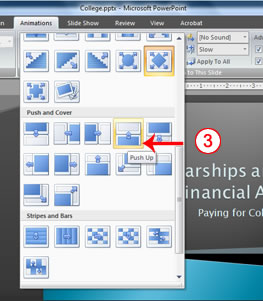 s
s- Click the Push Up transition. As you roll your pointer over each transition, PowerPoint provides you with a live preview of the transition.
Add Sound and Set the Speed

- Click the down arrow next to the Transition Sound field and then click Click.
- Click the down arrow next to the Transition Speed field and then click Slow.
Advance Slide
- Check the On Mouse Click check box.
- Click the Automatically After check box.
- Type 00:07 in the Automatically After text box.
- Click the Apply to All button
 . PowerPoint applies all of your changes to all of the slides.
. PowerPoint applies all of your changes to all of the slides. - Click Slide 1 on the Slides tab.
- Type 00:03 in the Automatically After text box. PowerPoint changes the timing for Slide 1.
References: elmhurst.edu/~jacobh/PowerPoint2007Instruction.ppt / classweb.gmu.edu/llmiller/AOCS/HowtoPPT.ppt
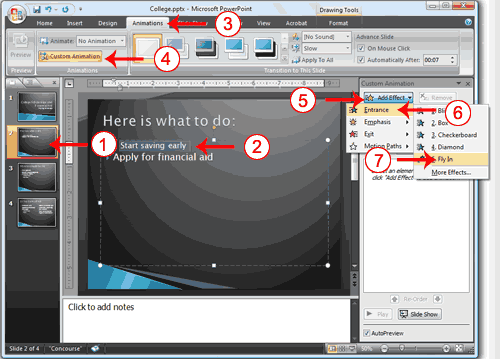
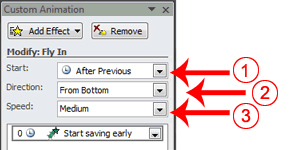

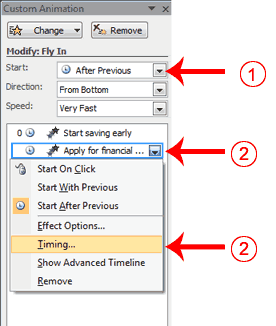
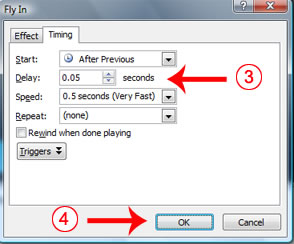
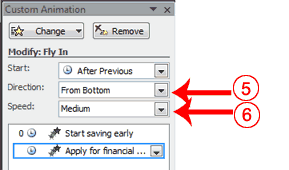

No comments:
Post a Comment